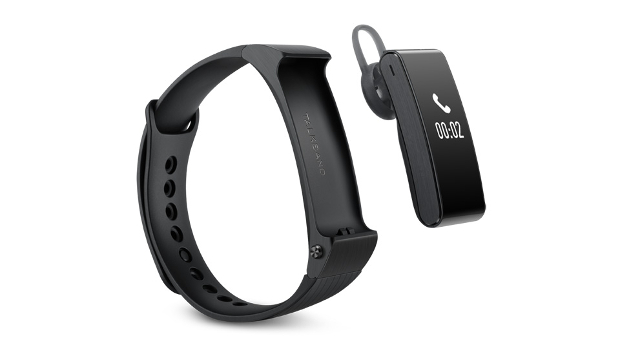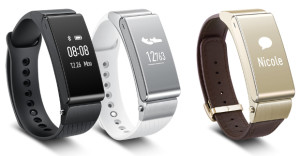Wearable technology is coming on in leaps and bounds in terms of usability and practicality, but feature sets are still quite fluid.
Huawei had made a previous play in this area with its Talkband B1, which was criticised for certain aspects of its design.
The Talkband B2 learns much from these lessons and is a slick, attractive package with an interesting differentiating feature.
The review model is the black version with the rubber/plastic strap, though there is also a gold version with a leather strap which is more expensive.
The screen is oblong rectangular, and initially displays time, date, battery and Bluetooth states. The watch works in conjunction with an Android or iOS application. Once synchronised with the app, the basic parameters are set with no need for set-up on the device itself.
The physical button on the side of the body is to wake the watch or a long press initiates a Bluetooth connection. Either side of the body/strap section there are release buttons. When a call comes through to the paired phone, simply press these two release buttons to free the main display piece to reveal a full Bluetooth headset. Pop it in your ear — and the pack contains three fitments for the ear piece — and answer the call, or use voice commands to interact with the phone. When finished, simply replace the device in the wrist band.
This unique feature sets the Talkband apart and makes it a very usable accessory, aside from its tracking capabilities.
The tracking is broken down across walking, running and cycling. A series of swipes up the screen gives a readout of steps, calories, kilometres travelled and time sleeping. That said, it attributed this tester’s motorcycle commute as cycling, which would have been rather impressive to have sustained speeds above 100 kph in terms of calorie burning.
Aside from this misinterpretation, it will recognise the difference between walking and running without having to be told.
The Talkband also monitors sleep cycles based on physical movements, and reports on these via the app.
The device also has a micro USB socket form which it charges. A full charge did indeed last the claimed three days plus, but it is still an unfamiliar action to have charge a timepiece so regularly.
The app itself is nicely presented and the reports clear, with an upload facility. Goals may be set and adjusted. Here alerts can also be set, such as turning on or off the inactivity alert that reminds the wearer to flex and move when it detects periods of inactivity.
One criticism was that it has a Bluetooth disconnection warning that is on by default. While at home, I don’t carry my phone in my pocket all the time. I found it very annoying to be reminded every few minutes that the Bluetooth connection had been lost while at the other end of the house or garden. Far from being down the east wing, this kind of alert is less than useful in this context. Perhaps a home detection based on Wi-Fi network or a 4G/GPS parameter could modify this feature.
Overall, this is a useful activity and sleep tracker that works just as well as a watch and comms headset. But at around €170 for the reviewed version, it is rather expensive for something that fits in the watch niche and yet requires charging every few of days.
If a fitness tracker is required for medical reasons, this is an excellent, attractive and usable device, but for the casual watch wearer, it is an expensive trinket that does not necessarily stack up beside a more traditional timepiece in the price bracket.
TechCentral Reporters









Subscribers 0
Fans 0
Followers 0
Followers